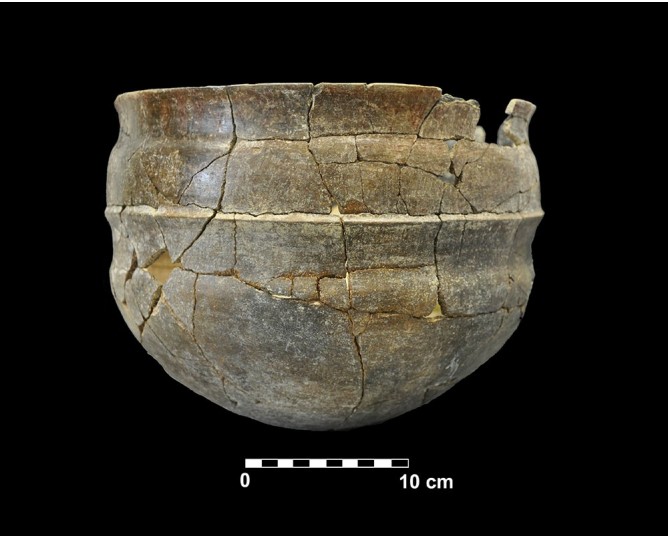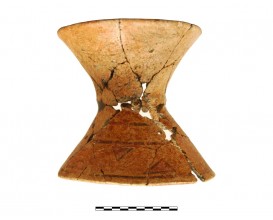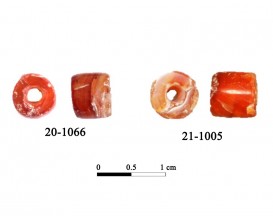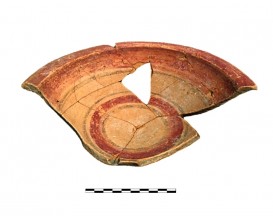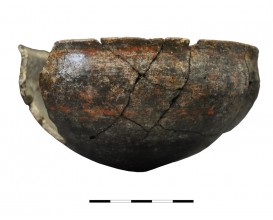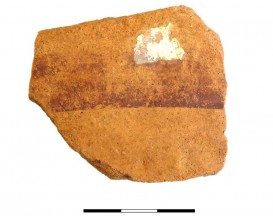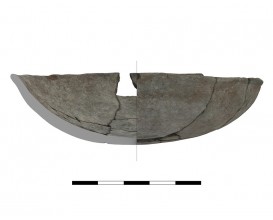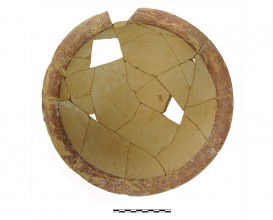Ceramic vessel 1011. Grave 5. Cemetery of Cerro de los Vientos (Baeza, Jaén, Spain)
Analysis of red decoration by MRS and EDXRF indicate that hematite (Fe2O3) is the mineral responsible for the red color. The concentration of Fe in the pigment is 16.12% wt.
The lipid content analysis has been performed using GC-MS obtaining a characteristic profile of beeswax: alkanes nC23 to nC33, long chain alcohols C24(OH) to C34(OH), palmitic acid wax esters W40 to W50) and hydroxymonosters W(OH)40 to W(OH)48.
Dimensions
: 22 Centimeters
: 30 Centimeters
Materials
pottery
Temporal
: Orientalising
: 8th-7th ct. BC
Spatial
: Cerro de los Vientos
: Puente del Obispo (Baeza, Jaén, Spain)
: WGS84
Copyrights
Creative Commons - Attribution, Non-Commercial, No Derivatives (BY-NC-ND)
References
Lechuga, M. A. y Soto, M. (2017): "La tumba de la mujer y el joven del Cerro de los Vientos (Puente del Obispo, Baeza)", en: Ruiz, A. y Molinos, M. (Eds.), Catálogo de la exposición La Dama, el Príncipe, el Héroe y la Diosa. Consejería de Cultura de la Junta de Andalucía, Sevilla, pp. 109-117.
Sánchez, A., Tuñón, J. A., Parras, D. J., Montejo, M., Lechuga, M. A., Ceprián, B., Soto, M., Luque, A. (2019): "Analyses by MRS, EDXRF and GC-MS for research on the ritual and funerary areas of Cerro de los Vientos (Jaén, Spain). Native and Eastern Mediterranean influences". Journal of Archaeological Science: Reports, 28. 102026
Digital Resources
-
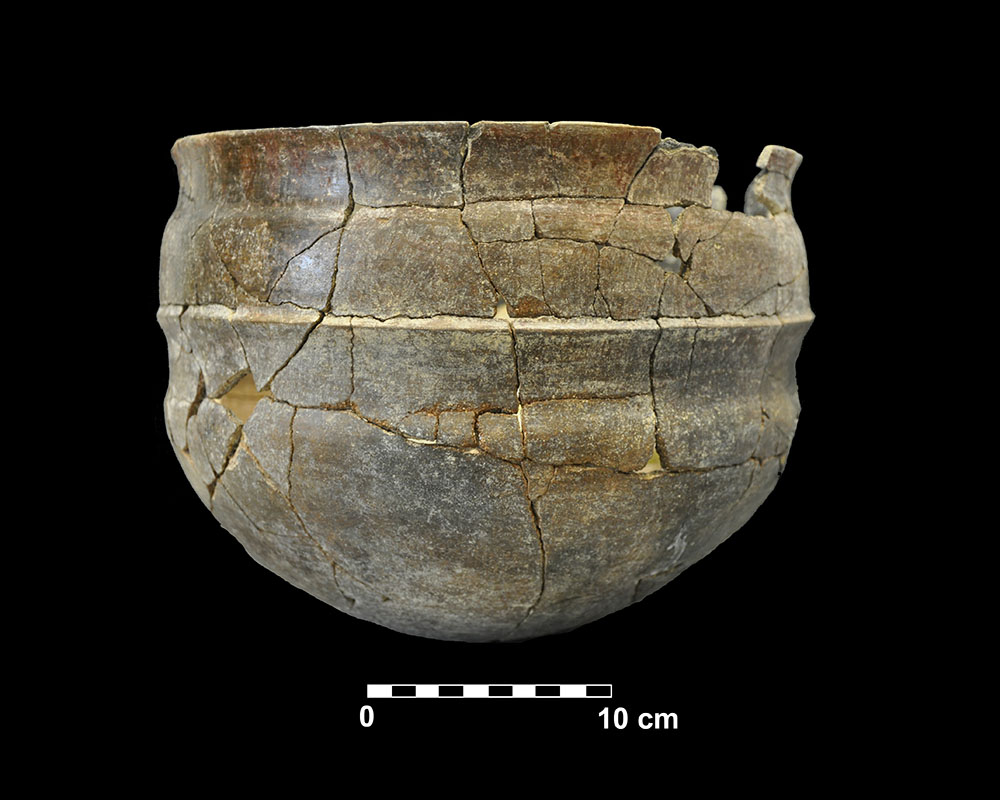 Instituto Universitario de Investigación en Arqueología Ibérica
Instituto Universitario de Investigación en Arqueología Ibérica Creative Commons - Attribution, Non-Commercial, No Derivatives (BY-NC-ND)
Arquiberlab
http://creativecommons.org/licenses/by-nc-nd/3.0/ -
 Instituto Universitario de Investigación en Arqueología Ibérica
Instituto Universitario de Investigación en Arqueología Ibérica Creative Commons - Attribution, Non-Commercial, No Derivatives (BY-NC-ND)
Arquiberlab
http://creativecommons.org/licenses/by-nc-nd/3.0/ -
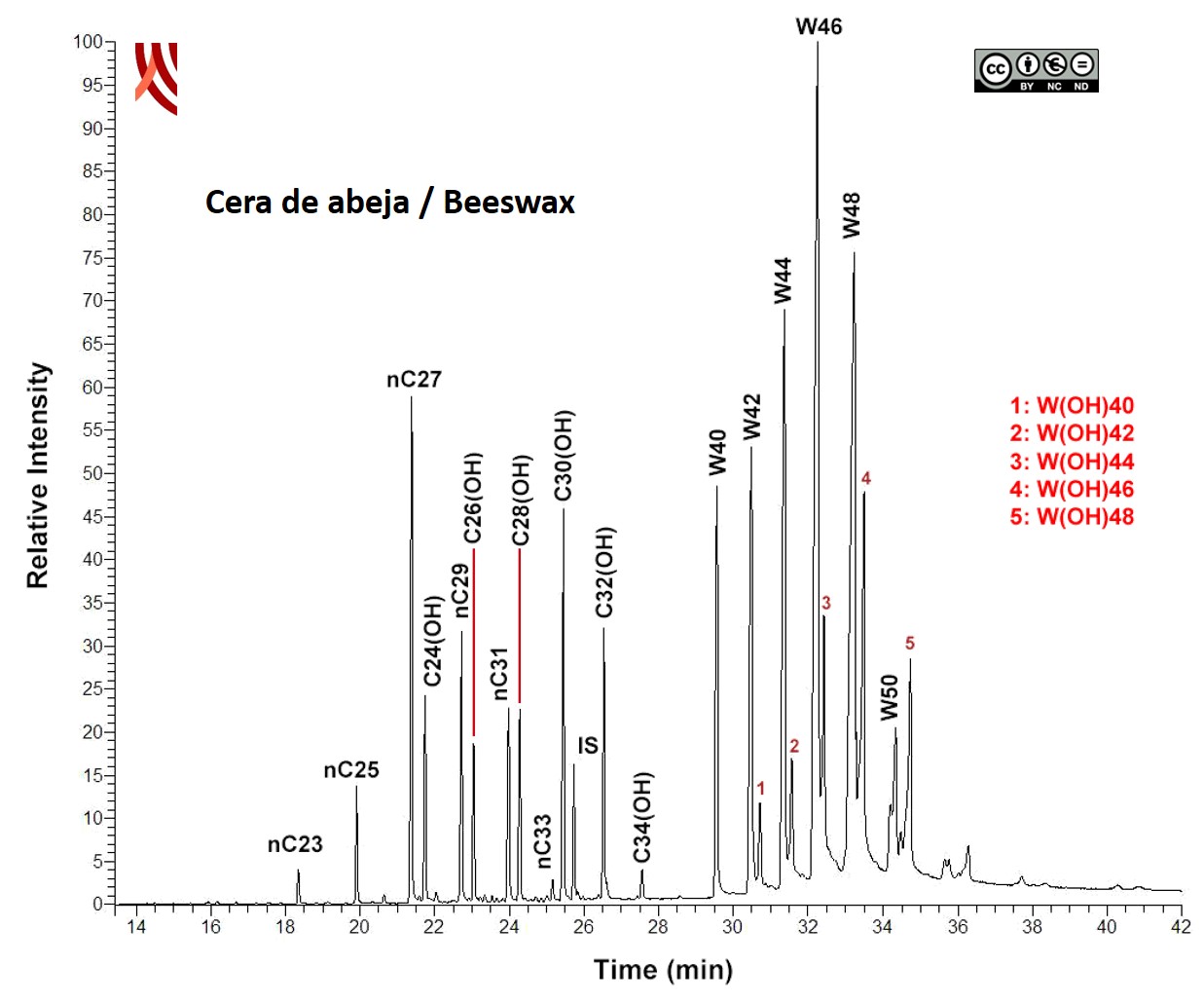 Instituto Universitario de Investigación en Arqueología Ibérica
Instituto Universitario de Investigación en Arqueología Ibérica Creative Commons - Attribution, Non-Commercial, No Derivatives (BY-NC-ND)
Arquiberlab
http://creativecommons.org/licenses/by-nc-nd/3.0/ - Instituto Universitario de Investigación en Arqueología Ibérica
pdf file
Creative Commons - Attribution, Non-Commercial, No Derivatives (BY-NC-ND)
Arquiberlab
http://creativecommons.org/licenses/by-nc-nd/3.0/ - Instituto Universitario de Investigación en Arqueología Ibérica
Creative Commons - Attribution, Non-Commercial, No Derivatives (BY-NC-ND)
Arquiberlab
http://creativecommons.org/licenses/by-nc-nd/3.0/
Activities
Archaeometric analysis Chromatographic analysis and structural determination Ceramic. Content analysis
| |
Gass Chromatography-Mass Spectrometry Pottery. Lipids analysis Destructive method for the identification of the total lipid profile: fatty acids, sterols, wax esters, fatty alcohols, triacylglycerols, etc. Any remains of soil were removed with an electric hand-drill. The sample was then grinded to the appropriate size in an agatha mortar (0.25 mm). Extraction with a the mixture chloroform/methanol (CHCl3:MeOH) (2:1 v/v) assisted by ultrasound. Derivatization of lipids to trimethylsilyl derivatives (TMS). The reaction tales place at 70 ºC for 30 min using N,O-bis-(trimethylsilyl) trifluoroacetamide (BSTFA) with 1 % trimethylchlorosilane (TMCS). The sample is solved in cyclohexane and then injected in GC-MS. Chromatographic separation is performed applying an adequate temperature programme. Gas chromatography-Mass Spectrometry (GC-MS) The analyses were performed using a using a gas chromatography equipment (model Thermo TraceGC Ultra) coupled to a Thermo DC Q II mass spectrometer. Autosampler Thermo Triplus (CICT, University of Jaén). The samples were introduced by on-column injection into a 15 m x 0.25 mm I.D. fused silica capillary column, coated with poly(dimethylsiloxane) stationary phase with 0.1 μm film thickness. Helium was used as the carrier gas (purity 99.99%) | |
X-Ray Fluorescence Elemental analysis of the red decoration Non destructive. Surface cleaning. Sample pretreatment is not required. Direct measurement. Energy dispersive X-ray fluorescence (EDXRF) An energy dispersive X-ray microfluorescence spectrometer (M4 Tornado, Bruker) was used for this paper (CICT, University of Jaen). This spectrometer is equipped with a microfocus X-ray tube with an Rh anode, a polycapillary lens for X-ray focussing, and a 30-mm2 energy dispersive detector (SDD). The sample chamber incorporates an XYZ motorized stage for sample positioning. A high resolution microscope is used to position the sample on the desired distance from the polycapillary. To increase the sensitivity of the low Z elements, the sample chamber can be brought under vacuum. For the analysis of the samples, a spot size of 25 μm was chosen at an operating X-ray tube voltage of 50 kV and intensity of 600 μA. The tube current was adapted for each sample in order to optimise the detection of X-rays. |

